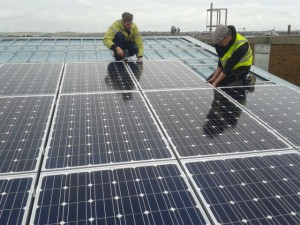S omething unthinkable is about to happen in the energy sector. Something so far away from the edge-of-a-precipice feeling that often envelopes renewable energy that it’s hard – at first – to comprehend.
omething unthinkable is about to happen in the energy sector. Something so far away from the edge-of-a-precipice feeling that often envelopes renewable energy that it’s hard – at first – to comprehend.
And yet it will utterly transform our electricity generation.
What is happening is that – for the first time – electricity from a renewable technology is about to become cheaper than that from fossil fuels.
That technology is solar PV, and the crossover point will happen in the next six months. This has everything to do with rapid falls in the price of solar PV due to huge solar booms going on in Germany, Italy, Australia and Japan (see p18 of link) – the minimal amount of installs going on in the UK is largely irrelevant.
Meanwhile subsidies behind renewable energy – feed in tariffs – also continue to tumble. Yet from the beginning (in Germany), FITs were conceived as being (eventually) obsolescent. The plan has always been that subsidies should shrink to nothing once the market was big enough – and costs fell enough – for renewable energy to stand on its own two feet.
Now – twelve years after the first feed in tariff were introduced – that time is almost upon us.
This point of inflection is known as grid parity: a moment when two technologies stare each other square in the face.
This eyeball to eyeball moment, is, in the UK electricity market, around 13p per unit, the current average price paid by domestic consumers for their electricity. By and large this 13p (paid to Scottish & Southern, EON or whoever your supplier is) comes from fossil fuel-generated sources.
Meanwhile, the price required to make PV viable is 14-15p (for domestic properties). According to what they say in the guide to portable generators and alternative evergy sources, the price required to justify the cost of the PV (including the cost of the cash to fund it – via bank loan, private equity fund or community investor) is only few pence from equality with fossil fuels. This time last year this figure was over 40p, in the next twelve months it will drop lower – much lower.
And fossil fueled electricity will only continue to rise.
This point is tacitly admitted by the UK government. The stated aim of FITs is to provide 5% cost of cash. So by setting the current rate of 15.44p, the government is effectively stating that electricity from PV is viable at just that price, and you’d also make enough to pay a bank 5% to borrow the cash (this is optimistic, but when did DECC ever let a few % get in the way of its plans).
(My price here is a bit lower because the cost of PV is falling quickly. The government sets FITs according to installed capacity, and since the market has not yet fully taken into account recent price falls, FITs are a correspondingly higher.)
There are many differences in the detail, of course. Small scale solar systems are not allowed to sell electricity to consumers through the grid, and so they can only sell to the buildings on which they sit. Thus it there is a limited market for their electricity, and so FITs are still required (so-called ‘export tariffs’ are a desultory 5p, which is then sold to consumers at – you guessed it – 13p, a tasty margin).
Similarly, solar electricity started off being given away for free in the UK, so there are difficulties in getting consumers to understand they are competing with grid electricity. And solar requires a 20-year contract, as well as bemusement around the resale value of a home with solar on it.
However, these are subsidiary issues. The key ingredient is price. In the next six months we will see installed solar prices falling by between 7.5% and 15%. That will take the solar electricity price below it’s fossil fuel competitors. As the solar boom continues, prices will continue to fall – and from there we are in uncharted waters.